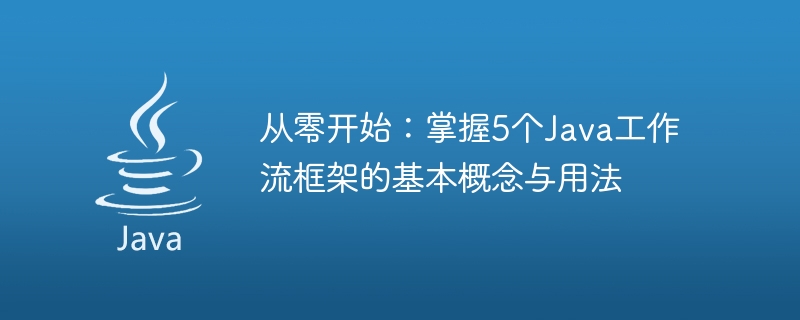Home >Java >javaTutorial >Learn the basic concepts and usage of 5 commonly used Java workflow frameworks: from entry to proficiency
Learn the basic concepts and usage of 5 commonly used Java workflow frameworks: from entry to proficiency
- PHPzOriginal
- 2023-12-27 12:26:301570browse

Start from scratch: Master the basic concepts and usage of 5 Java workflow frameworks
Introduction
In the field of software development, workflow is a An important concept used to describe and manage complex business processes. As a widely used programming language, Java also has many excellent workflow frameworks for developers to choose from. This article will introduce the basic concepts and usage of 5 Java workflow frameworks to help readers get started quickly.
1. Activiti
Activiti is an open source BPM (Business Process Management) engine. It supports process definition, process instance management, task management, form engine and other functions. Activiti uses the BPMN 2.0 standard to describe workflows and has good cross-platform and scalability. When using Activiti, you first need to define a process model, and then create process instances based on the model. By using the API to interact with Activiti, you can control and manage the process.
2. jBPM
jBPM is a powerful open source workflow engine that provides flexible workflow management and process automation functions. jBPM is based on BPMN 2.0 and uses a graphical editor to create and edit process models. Developers can define the behavior of the process by writing rules and scripts, and can integrate various systems and services. jBPM also provides complete task management and logging functions to facilitate developers to monitor and debug.
3. Camunda
Camunda is a lightweight open source workflow engine that provides fast and flexible workflow management functions. Camunda uses BPMN 2.0 to model processes, and developers can create and modify process models through a graphical editor. Camunda supports various platforms and environments and can be seamlessly integrated with frameworks such as Java, Spring, and Java EE. Camunda also provides a wealth of APIs and tools to facilitate developers to manage and monitor process instances.
4. Spring Workflow
Spring Workflow is part of the Spring framework, which provides a set of functions for process management and execution. Spring Workflow uses a state machine model to describe the process, and developers can define the state and transition rules of the process through configuration files or coding. Spring Workflow encapsulates the underlying process control logic and provides simple and easy-to-use APIs and annotations to facilitate development and integration by developers.
5. Flowable
Flowable is a lightweight open source workflow engine and the successor of the Activiti framework. Flowable provides almost the same functionality as Activiti, with some improvements and optimizations in details. Flowable uses BPMN 2.0 to model processes, operating and managing process instances through the use of APIs and graphical editors. Flowable also supports various extensions and plug-ins, and is very convenient to integrate with frameworks such as Spring.
Conclusion
The above are the basic concepts and usage of five commonly used Java workflow frameworks. Each framework has its own characteristics and advantages, and choosing the appropriate framework depends on project needs and personal preferences. I hope this article can help readers master the basic knowledge of these frameworks and be handy in actual development. Through learning and practice, I believe readers can make better use of these workflow frameworks to improve the efficiency and quality of software development.
The above is the detailed content of Learn the basic concepts and usage of 5 commonly used Java workflow frameworks: from entry to proficiency. For more information, please follow other related articles on the PHP Chinese website!

